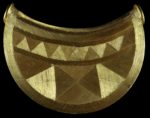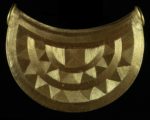 A gold bulla discovered by a metal detectorist in the Shropshire Marshes was one of the stars of the Portable Antiquities Annual Report unveiled at the British Museum on Tuesday. About 3,000 years old, it is the most south-westerly example of Bronze Age gold ever found in Britain and is one of only eight extant bullae found in Britain and Ireland. The only other bulla ever discovered in England was dredged from the Irwell ship canal in the 18th century, was sold for a couple of pounds and disappeared from the record. It is an exceptional piece.
A gold bulla discovered by a metal detectorist in the Shropshire Marshes was one of the stars of the Portable Antiquities Annual Report unveiled at the British Museum on Tuesday. About 3,000 years old, it is the most south-westerly example of Bronze Age gold ever found in Britain and is one of only eight extant bullae found in Britain and Ireland. The only other bulla ever discovered in England was dredged from the Irwell ship canal in the 18th century, was sold for a couple of pounds and disappeared from the record. It is an exceptional piece.
 This kind of jewelry is known as a bulla after the Latin word for bubble because it’s hollow inside. It is crescent-shaped with wedge-shaped sides and was created using at least two pieces of gold sheet. The top edge has collars on either side that were filled with clay or compacted soil, either deliberately or over the centuries it was buried. Between them is a tunnel which would have been used to thread a chain or necklace through to hang it as a pendant. The front and rear plates that make the body of the pendant are a single sheet of gold plate fixed at the mid-point of the top edge. A base plate closes the two sides of the plate. The fixing points are concealed so the plates and tube collar look like a single piece.
This kind of jewelry is known as a bulla after the Latin word for bubble because it’s hollow inside. It is crescent-shaped with wedge-shaped sides and was created using at least two pieces of gold sheet. The top edge has collars on either side that were filled with clay or compacted soil, either deliberately or over the centuries it was buried. Between them is a tunnel which would have been used to thread a chain or necklace through to hang it as a pendant. The front and rear plates that make the body of the pendant are a single sheet of gold plate fixed at the mid-point of the top edge. A base plate closes the two sides of the plate. The fixing points are concealed so the plates and tube collar look like a single piece.
 The components were probably soldered together as the use of solder is well-established in metal objects from this period in Britain. The composition of the bulla was tested with XRF-analysis, but the presence of solder — which in Bronze Age objects is higher in copper or silver than the rest of the piece — could not be conclusively identified.
The components were probably soldered together as the use of solder is well-established in metal objects from this period in Britain. The composition of the bulla was tested with XRF-analysis, but the presence of solder — which in Bronze Age objects is higher in copper or silver than the rest of the piece — could not be conclusively identified.
 The most striking element of the bulla is the decoration. Every surface is engraved with geometric designs filled with cut parallel lines and concentric curves. They are so precise, so even that the maker must have used a compass or divider to mark them out and then cut them using a graver with a 45 degree cutting edge. There are no punched or repousse patterns as have been found on other bullae. The deep grooves carved all over the piece suggest the gold sheet is comparatively thick and that the decoration was done on the completed pendant rather than on the sheets before they were put together.
The most striking element of the bulla is the decoration. Every surface is engraved with geometric designs filled with cut parallel lines and concentric curves. They are so precise, so even that the maker must have used a compass or divider to mark them out and then cut them using a graver with a 45 degree cutting edge. There are no punched or repousse patterns as have been found on other bullae. The deep grooves carved all over the piece suggest the gold sheet is comparatively thick and that the decoration was done on the completed pendant rather than on the sheets before they were put together.
To top it off, the lines go in alternating horizontal, vertical, semi-circular and diagonal directions, creating a dynamic graphic look as well as an incredible play of light that makes the gold reflect in different shades that underscore the intricate shapes. This is work of the highest quality, the greatest possible workmanship, material and design that is all but incomparable in a British context.
